
Tibetan Buddhism is a form of Buddhism practiced in Tibet, Bhutan and Mongolia. It also has a sizable number of adherents in the areas surrounding the Himalayas, including the Indian regions of Ladakh, Sikkim, and Arunachal Pradesh, as well as in Nepal. Smaller groups of practitioners can be found in Central Asia, Xinjiang, Inner Mongolia, and some regions of Russia, such as Tuva, Buryatia, and Kalmykia.
A tulku is a distinctive and significant aspect of Tibetan Buddhism, embodying the concept of enlightened beings taking corporeal forms to continue the lineage of specific teachings. The term "tulku" has its origins in the Tibetan word "sprul sku", which originally referred to an emperor or ruler taking human form on Earth, signifying a divine incarnation. Over time, this term evolved within Tibetan Buddhism to denote the corporeal existence of highly accomplished Buddhist masters whose purpose is to ensure the preservation and transmission of a particular lineage.
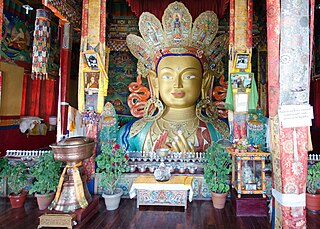
The vast majority of surviving Tibetan art created before the mid-20th century is religious, with the main forms being thangka, paintings on cloth, mostly in a technique described as gouache or distemper, Tibetan Buddhist wall paintings, and small statues in bronze, or large ones in clay, stucco or wood. They were commissioned by religious establishments or by pious individuals for use within the practice of Tibetan Buddhism and were manufactured in large workshops by monks and lay artists, who are mostly unknown. Various types of religious objects, such as the phurba or ritual dagger, are finely made and lavishly decorated. Secular objects, in particular jewellery and textiles, were also made, with Chinese influences strong in the latter.
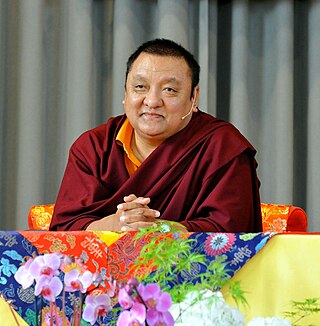
The Shamarpa, also known as Shamar Rinpoche, or more formally Künzig Shamar Rinpoche, is the second oldest lineage of tulkus. He is one of the highest lineage holders of the Karma Kagyu school of Tibetan Buddhism and is regarded as the mind manifestation of Amitābha. He is traditionally associated with Yangpachen Monastery near Lhasa.

Tibet developed a distinct culture due to its geographic and climatic conditions. While influenced by neighboring cultures from China, India, and Nepal, the Himalayan region's remoteness and inaccessibility have preserved distinct local influences, and stimulated the development of its distinct culture.
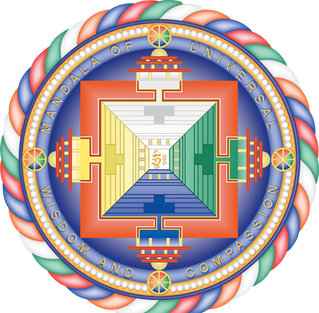
The Foundation for the Preservation of the Mahayana Tradition (FPMT) was founded in 1975 by Gelugpa Lamas Thubten Yeshe and Thubten Zopa Rinpoche, who began teaching Tibetan Buddhism to Western students in Nepal. The FPMT has grown to encompass over 138 dharma centers, projects, and services in 34 countries. Lama Yeshe led the organization until his death in 1984, followed by Lama Zopa until his death in 2023. The FPMT is now without a spiritual director; meetings on the organization's structure and future are planned.
The Pratimokṣa is a list of rules governing the behaviour of Buddhist monastics. Prati means "towards" and mokṣa means "liberation" from cyclic existence (saṃsāra).

Buddhism is the largest religion in Mongolia practiced by 51.7% of Mongolia's population, according to the 2020 Mongolia census. Buddhism in Mongolia derives much of its recent characteristics from Tibetan Buddhism of the Gelug and Kagyu lineages, but is distinct and presents its own unique characteristics.
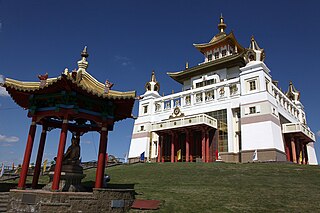
The Kalmyks are the only Mongolic-speaking people of Europe whose national religion is Buddhism. In 2016, 53.4% of the population surveyed identified themselves as Buddhist. They live in Kalmykia, a federal subject of Russia in the southwest. Kalmykia borders Dagestan to the south, Stavropol Krai to the southwest, Rostov Oblast to the west, Volgograd Oblast to the northwest, and Astrakhan Oblast to the east. The Caspian Sea borders Kalmykia to the southeast.

Women in Buddhism is a topic that can be approached from varied perspectives including those of theology, history, anthropology, and feminism. Topical interests include the theological status of women, the treatment of women in Buddhist societies at home and in public, the history of women in Buddhism, and a comparison of the experiences of women across different forms of Buddhism. As in other religions, the experiences of Buddhist women have varied considerably.

Bruce Alan Wallace is an American author and expert on Tibetan Buddhism. His books discuss Eastern and Western scientific, philosophical, and contemplative modes of inquiry, often focusing on the relationships between science and Buddhism. He is founder of the Santa Barbara Institute for Consciousness Studies.
State Religious Affairs Bureau Order No. 5, officially named Measures on the Management of the Reincarnation of Living Buddhas in Tibetan Buddhism, is an order passed during a conference of the State Administration for Religious Affairs on 13 July 2007, marked for implementation on 1 September 2007.
Buddhism in the United Kingdom has a small but growing number of adherents which, according to a Buddhist organisation, is mainly a result of conversion. In the UK census for 2011, there were about 247,743 people who registered their religion as Buddhism, and about 174,000 who cited religions other than Christianity, Buddhism, Hinduism, Judaism, Islam, Jainism and Sikhism. This latter figure is likely to include some people who follow the traditional Chinese folk religion which also includes some elements of Buddhism.

The 14th Dalai Lama is, as the incumbent Dalai Lama, the highest spiritual leader and head of Tibetan Buddhism. By the adherents of Tibetan Buddhism, he is considered a living Bodhisattva; specifically, an emanation of Avalokiteśvara in Sanskrit, and Chenrezig in Tibetan. He is also the leader and a monk of the Gelug school, the newest school of Tibetan Buddhism, formally headed by the Ganden Tripa. The central government of Tibet at the time of his selection, the Ganden Phodrang, invested the Dalai Lama with temporal duties until his exile in 1959.
Geshe Tenzin Zopa is a Tibetan Buddhist monk of the Mahayana tradition. He is the resident teacher of the Losang Dragpa Centre of the Foundation for the Preservation of the Mahayana Tradition (FPMT). Zopa is featured in the 2008 documentary film Unmistaken Child, which follows his search for the reincarnation of his beloved master, Geshe Lama Konchog. Zopa has also written a book about this search, titled Precious Holy Child of Kopan.

A bhikkhunī or bhikṣuṇī is a Buddhist nun, fully ordained female in Buddhist monasticism. Bhikkhunis live by the Vinaya, a set of either 311 Theravada, 348 Dharmaguptaka, or 364 Mulasarvastivada school rules. Until recently, the lineages of female monastics only remained in Mahayana Buddhism and thus were prevalent in countries such as China, Korea, Taiwan, Japan, and Vietnam, while a few women have taken the full monastic vows in the Theravada and Vajrayana schools. The official lineage of Tibetan Buddhist bhikkhunis recommenced on 23 June 2022 in Bhutan when 144 nuns were fully ordained.
The incumbent 14th Dalai Lama once suggested the different possibilities of reincarnation for the next (15th) Dalai Lama, but because of the feudal origin of the Dalai Lama reincarnation system, he suggested the reincarnation system should end. The selection process remains controversial, as the atheist Chinese government has declared ownership on the selection process using the Golden Urn for the next Dalai Lama.
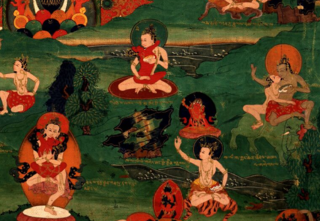
Karmamudrā is a Vajrayana Buddhist technique which makes use of sexual union with a physical or visualized consort as well as the practice of inner heat (tummo) to achieve a non-dual state of bliss and insight into emptiness. In Tibetan Buddhism, proficiency in inner heat yoga is generally seen as a prerequisite to the practice of karmamudrā.

Chinese Esoteric Buddhism refers to traditions of Tantra and Esoteric Buddhism that have flourished among the Chinese people. The Tantric masters Śubhakarasiṃha, Vajrabodhi and Amoghavajra, established the Esoteric Buddhist Zhenyan tradition from 716 to 720 during the reign of Emperor Xuanzong of Tang. It employed mandalas, mantras, mudras, abhiṣekas, and deity yoga. The Zhenyan tradition was transported to Japan as Shingon Buddhism by Kūkai as well as influencing Korean Buddhism and Vietnamese Buddhism. The Song dynasty (960–1279) saw a second diffusion of Esoteric texts. Esoteric Buddhist practices continued to have an influence into the late imperial period and Tibetan Buddhism was also influential during the Yuan dynasty period and beyond. In the Ming dynasty (1368–1644) through to the modern period, esoteric practices and teachings became absorbed and merged with the other Chinese Buddhist traditions to a large extent.












